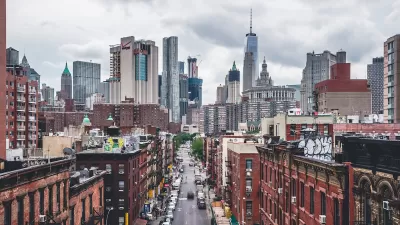Witold Rybczynski reports on a recent conference at the University of Pennsylvania at which planners emphasized technology. He thinks that there is more to it than that.
"if Americans are to significantly reduce their carbon footprint, we will have to do a lot more than switch to reusable shopping bags and recycle our soda cans. But as a recent conference on "urban design after the age of oil" at the University of Pennsylvania (where I teach) demonstrated, there is something of a disconnect between the global-warming problem and the available solutions.
"The Penn conference featured many speakers proposing changes, large and small, as to how buildings and cities should be designed. The scientists were hard-nosed and slightly scary. Planning consultants were authoritative and self-assured-as planning consultants tend to be. They described new carbon-neutral cities, with wind farms and solar arrays, green roofs and urban farms, far-ranging mass transit, and large-scale water recycling. The Power Point images were mesmerizing. Most of the projects appear to be in the Gulf states. In the present economy, most are, I suspect, on hold.
"Most of the planners at the Penn conference emphasized technological fixes, but if the point of no return has already been passed in global warming, as some of the scientists at the conference suggested, protective measures are at least as important, not least against the anticipated rise in sea levels."
Thanks to Franny

Study: Maui’s Plan to Convert Vacation Rentals to Long-Term Housing Could Cause Nearly $1 Billion Economic Loss
The plan would reduce visitor accommodation by 25,% resulting in 1,900 jobs lost.

Placekeeping: Setting a New Precedent for City Planners
How a preservation-based approach to redevelopment and urban design can prevent displacement and honor legacy communities.

Using Old Oil and Gas Wells for Green Energy Storage
Penn State researchers have found that repurposing abandoned oil and gas wells for geothermal-assisted compressed-air energy storage can boost efficiency, reduce environmental risks, and support clean energy and job transitions.

Washington State Plans Ambitious ‘Cycle Highway’ Network
The state is directing funding to close gaps in its existing bike network and make long-distance trips more accessible.

Homeowners Blame PG&E for Delays in ADU Permits
The utility says it has dramatically reduced its backlog, but applicants say they still face months-long delays for approvals for new electrical work.

Rethinking Wildfire Defense: How a Landscape Approach Can Protect Neighborhoods
Post-fire analysis of the Eaton Fire reveals that a landscape approach — including fire-resistant vegetation, home hardening, and strategic planning — can help reduce wildfire risk, challenging assumptions that trees and plants are primary fire hazards.
Urban Design for Planners 1: Software Tools
This six-course series explores essential urban design concepts using open source software and equips planners with the tools they need to participate fully in the urban design process.
Planning for Universal Design
Learn the tools for implementing Universal Design in planning regulations.
Borough of Carlisle
Caltrans
Heyer Gruel & Associates PA
Institute for Housing and Urban Development Studies (IHS)
City of Grandview
Harvard GSD Executive Education
Salt Lake City
NYU Wagner Graduate School of Public Service
City of Cambridge, Maryland




























